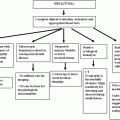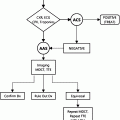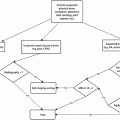William R. Reinus (ed.)Clinician’s Guide to Diagnostic Imaging201410.1007/978-1-4614-8769-2_7
© Springer Science+Business Media New York 2014
7. Approach to Vascular Imaging
(1)
Department of Radiology, Temple University Hospital, 3401 N. Broad Street, Philadelphia, PA 19140, USA
Abstract
Imaging of the vascular system, in theory, is straightforward. The choice of imaging modality depends on many factors, including the type of lesion suspected and its anatomic location. Ultrasound (US), computed tomographic angiography (CTA), magnetic resonance angiography (MRA), and conventional angiography comprise the main modalities used to image the vascular system. Each has its advantages and disadvantages. In general, conventional digital subtraction angiography (DSA) is the current gold standard for vascular evaluation. Because this modality requires catheterization of an artery, it is not without risk and should generally be reserved for emergencies, clinical questions where other modalities have proven inadequate or possible therapeutic interventions. Other modalities offer less invasive ways to evaluate the vascular system and provide information needed for diagnosis and treatment.
Introduction
Imaging of the vascular system, in theory, is straightforward. The choice of imaging modality depends on many factors, including the type of lesion suspected and its anatomic location. Ultrasound (US), computed tomographic angiography (CTA), magnetic resonance angiography (MRA), and conventional angiography comprise the main modalities used to image the vascular system. Each has its advantages and disadvantages. In general, conventional digital subtraction angiography (DSA) is the current gold standard for vascular evaluation. Because this modality requires catheterization of an artery, it is not without risk and should generally be reserved for emergencies, clinical questions where other modalities have proven inadequate or possible therapeutic interventions. Other modalities offer less invasive ways to evaluate the vascular system and provide information needed for diagnosis and treatment.
Ultrasound
Of the four modalities mentioned above, ultrasound is the least invasive. It allows imaging of superficial vessels without radiation or intravenous contrast administration. An ultrasound transducer, or probe, is placed on the skin and used to evaluate the underlying vasculature. Real time grey scale images and color Doppler imaging can be performed to evaluate the patency of vessels, evaluate changes in vessel flow patterns through the cardiac cycle and also the proximity of adjacent structures to vascular pathology.
US has disadvantages, including difficulty imaging through adipose tissue, gas, and bone; limitations on its field of view; and dependence on the sonographer’s skill. In general, US is well suited to evaluate lower extremity DVT. In obese patients, however, adipose tissue may prevent sufficient penetration and reflection of the sound waves, making diagnostic images difficult to obtain. The vasculature in the abdomen and the brain can be obscured by bowel gas and bone, respectively, again making imaging difficult, if not impossible.
Today, US is performed using hand held, real-time transducers. The volume of tissue visible at any given time is relatively limited compared with other techniques. Therefore, it is possible to overlook pathology even when a scan has been performed carefully. Finally, ultrasound is dependent on the skill of the person performing the study. Although US images are interpreted by a radiologist, a sonographer performs the initial scan. Because of the limited field of view and the freehand nature of scanning, the quality of US images is influenced heavily by the experience and training of the sonographer. It is then up to the radiologist to determine whether or not additional images are required or if he should scan the patient personally.
CT Angiography
Multidetector computed tomography (CT) with contrast administration is another common way to evaluate vascular structures. It is more invasive than ultrasound, requiring intravenous access and administration of iodinated contrast. In addition, CT uses ionizing radiation. Imaging after intravenous contrast injection must be timed properly to obtain opacification of the desired vessels. Arterial phase imaging requires a rapid rate of intravenous contrast administration as well as bolus tracking—repeated imaging with a detector over a vessel—to ensure the arterial system is enhanced properly. Similarly, enhancement of the venous system requires appropriate timing of image acquisition but this is not as sensitive to timing as arterial imaging.
As with all intravenously contrast injected CT scans, a small percentage of patients will have an allergic reaction to the contrast material. This reaction can range from benign urticaria to full blown anaphylaxis with cardiorespiratory collapse. Fortunately, the latter is uncommon.
Benefits of CT angiography include ease of accessibility, with multidetector CT (MDCT) available in most hospitals and outpatient centers. CTA generally is performed using standard protocols which limit operator dependence. CTA allows clear anatomic evaluation not only of the vessels, but also of adjacent structures
Magnetic Resonance Angiography
MRA uses magnetic resonance imaging (MRI) techniques to generate images of the flowing blood through a vessel and thus shows the intimal walls of the vessel in relief. Images can be obtained either with or without injected intravenous contrast media. MRI takes advantage of the inherent molecular differences among different types of tissue to generate the images. In general, two different techniques are available to obtain images without contrast, phase contrast imaging, and time of flight imaging. The former relies on the difference in signal of protons in stationary and mobile tissue. The latter relies on the protons flowing into the imaged slice having no out of plane magnetization at the time of image acquisition. Each of these techniques is limited by various technical issues that determine where they may be used. 3D contrast-enhanced MRA is performed with an intravenous injection of gadolinium-based contrast agent and generally provides higher quality images than both non-contrast techniques.
MRA uses no radiation. Radio frequency energy is deposited in the tissues with MRI, but thus far, no significant health risks have been identified related to this. Furthermore, MR contrast agents are of a different class than the iodinated agents used with CTA and conventional angiography. Patients with allergy to the latter have no crossover with MR contrast. In fact, true allergic reactions to gadolinium-based MR contrast agents are rare. So MRA can be useful in patients with a known iodinated contrast allergy.
Nonetheless, MRA has significant limitations, including high expense, the relatively long time required for image acquisition, and the risk of nephrogenic systemic fibrosis (NSF). NSF is a rare syndrome believed to be related to gadolinium contrast exposure, primarily in patients with low glomerular filtration rates either from acute or chronic renal failure. Patients develop fibrosis of skin, joints, and internal organs (See Chap. 1 for further discussion). Recognition of NSF has limited the use of MRA as an alternative to CTA in patients with limited renal function.
Conventional Angiography
Conventional angiography, also called DSA and catheter-directed angiography, directly visualizes the target vessels and so is the gold standard of vascular imaging. Using this technique, a catheter is placed directly into the vessel and imaged by injecting iodinated contrast. In many cases, because the catheter is present in the vessel, pathology can be both diagnosed and treated during the same procedure.
Even so, this technique also has disadvantages. It is the most invasive of all techniques used to evaluate the vasculature. There are risks to performing a procedure including bleeding, vessel injury, inducing thrombosis within a small vessel, creating an embolic thrombus and, of course, contrast-induced nephropathy. Patients who are on blood thinners are at increased risk of bleeding when undergoing DSA. Access into the vascular system in patients with severe atherosclerotic disease may be precluded if the common femoral artery, the entry vessel of choice, is heavily calcified or occluded. In these instances, a radial or brachial artery approach could be considered. Iodinated contrast material is used for this procedure, and as with CTA this places patients at risk for allergic contrast reaction and contrast-induced nephropathy. It should be mentioned, however, that for unknown reasons, patients who receive intra-arterial contrast are at much lower risk for allergic contrast reactions than those who receive intravenous contrast.
Head/Neck Vascular Imaging
Carotid Artery Narrowing
Carotid artery atherosclerotic disease is a major preventable cause of stroke [1]. Imaging is undertaken when there are clinical indications, e.g., carotid bruit or transient ischemic attack, indicating that a patient may have carotid stenosis or a build-up of atherosclerotic plaque. The mainstay of carotid imaging is noninvasive duplex ultrasound. This procedure has become accepted widely as the first test of choice for imaging carotid stenosis in a patient with clinical risk factors. CTA and MRA may also be considered but have the disadvantages of cost, contrast, and radiation exposure. These tests are generally reserved for patients in whom ultrasound is equivocal or non-diagnostic.
Carotid Artery or Vertebral Artery Dissection
In a setting of trauma, carotid or vertebral artery dissection may be suspected when a patient has head or neck pain and neurologic symptoms such as dysarthria, weakness, ataxia, or scotoma. Cross-sectional imaging, either with CTA or MRA, has become the standard imaging technique because of its noninvasive nature and widespread availability [2]. Conventional angiography is generally reserved for cases where noninvasive methods are not diagnostic.
Internal Jugular Vein Thrombosis
Internal jugular vein thrombosis occurs in a number of settings. Patients with a history of head and neck infections, recent surgery, indwelling catheters, and/or drug use are at risk for thrombosing their Jugular vein. Propagation of thrombus including pulmonary embolism is associated with internal jugular vein thrombosis. Because of the morbidity and mortality associated with jugular thrombosis, diagnosis is important [3]. Here again, duplex ultrasonography is the first-line diagnostic test because it is readily available, safe, can be performed at the bedside if necessary, and is noninvasive. CTA and MRA are used as second-line tests when ultrasound is non-diagnostic.
Upper Extremity Deep Venous Thrombosis
Other than in dialysis patients, upper extremity deep venous thrombosis (DVT) is uncommon. It is associated with significant morbidity and mortality because of risk of pulmonary embolism, loss of venous access, and post-thrombotic syndrome [4]. Two forms of upper extremity DVT are described: Paget von Schrotter or effort thrombosis and secondary thrombosis. In effort thrombosis, a chronic compression at the thoracic inlet or outlet resulting from musculoskeletal structures in the costoclavicular space causes slow venous return and ultimately thrombosis in the veins of the extremity. Secondary thrombosis usually is caused by either hypercoagulable states or indwelling catheters. Color flow duplex imaging diagnoses upper extremity venous thrombosis with 78–100 % sensitivity and 82–100 % specificity making it the first-line study [5]. Diagnosis with duplex ultrasound can be limited by the overlying clavicle. In equivocal cases, catheter-directed venogram can be helpful both for diagnosis and treatment.
Arterial Vasculidities
Stay updated, free articles. Join our Telegram channel

Full access? Get Clinical Tree








